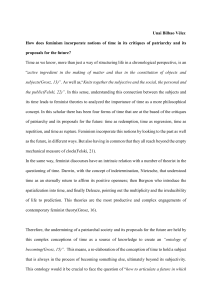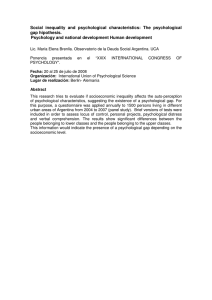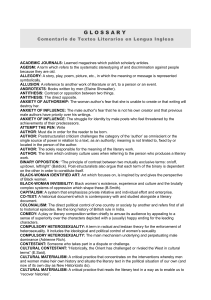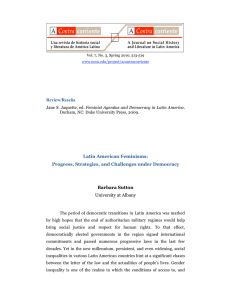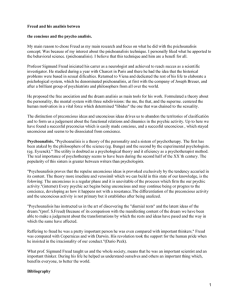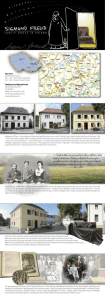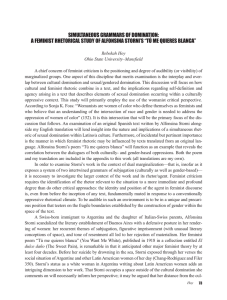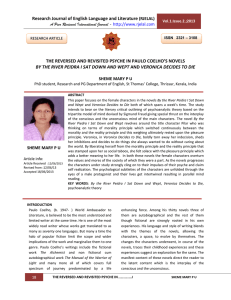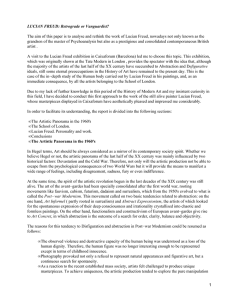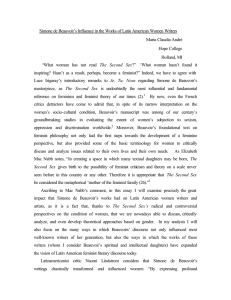Interpretación de la literatura
Anuncio
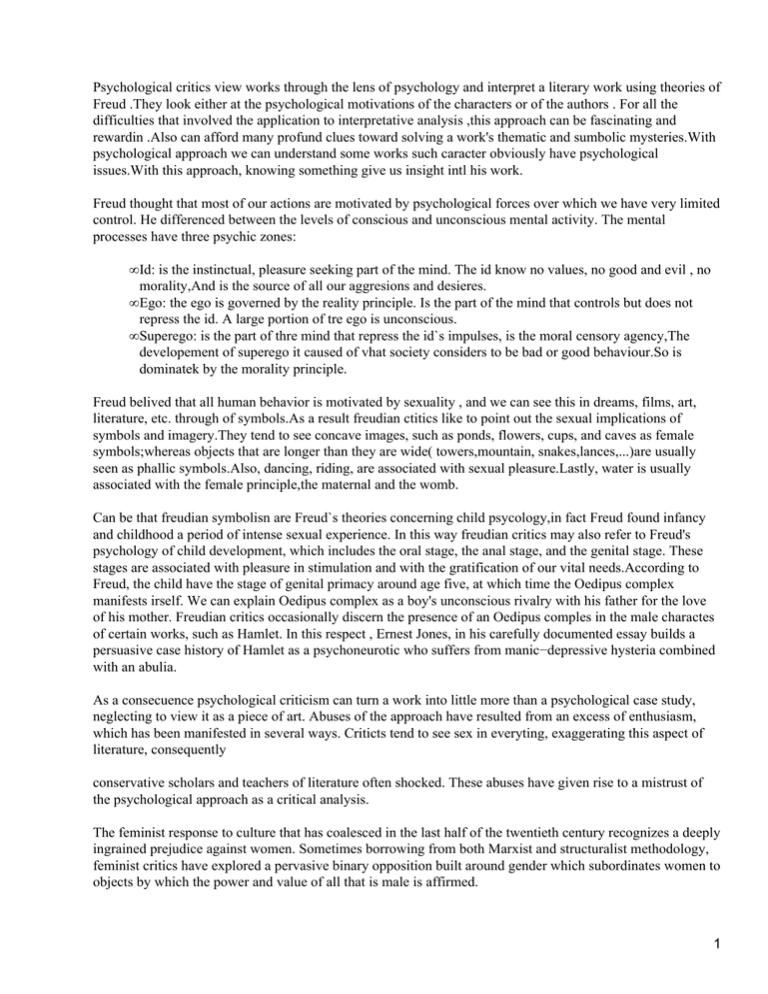
Psychological critics view works through the lens of psychology and interpret a literary work using theories of Freud .They look either at the psychological motivations of the characters or of the authors . For all the difficulties that involved the application to interpretative analysis ,this approach can be fascinating and rewardin .Also can afford many profund clues toward solving a work's thematic and sumbolic mysteries.With psychological approach we can understand some works such caracter obviously have psychological issues.With this approach, knowing something give us insight intl his work. Freud thought that most of our actions are motivated by psychological forces over which we have very limited control. He differenced between the levels of conscious and unconscious mental activity. The mental processes have three psychic zones: • Id: is the instinctual, pleasure seeking part of the mind. The id know no values, no good and evil , no morality,And is the source of all our aggresions and desieres. • Ego: the ego is governed by the reality principle. Is the part of the mind that controls but does not repress the id. A large portion of tre ego is unconscious. • Superego: is the part of thre mind that repress the id`s impulses, is the moral censory agency,The developement of superego it caused of vhat society considers to be bad or good behaviour.So is dominatek by the morality principle. Freud belived that all human behavior is motivated by sexuality , and we can see this in dreams, films, art, literature, etc. through of symbols.As a result freudian ctitics like to point out the sexual implications of symbols and imagery.They tend to see concave images, such as ponds, flowers, cups, and caves as female symbols;whereas objects that are longer than they are wide( towers,mountain, snakes,lances,...)are usually seen as phallic symbols.Also, dancing, riding, are associated with sexual pleasure.Lastly, water is usually associated with the female principle,the maternal and the womb. Can be that freudian symbolisn are Freud`s theories concerning child psycology,in fact Freud found infancy and childhood a period of intense sexual experience. In this way freudian critics may also refer to Freud's psychology of child development, which includes the oral stage, the anal stage, and the genital stage. These stages are associated with pleasure in stimulation and with the gratification of our vital needs.According to Freud, the child have the stage of genital primacy around age five, at which time the Oedipus complex manifests irself. We can explain Oedipus complex as a boy's unconscious rivalry with his father for the love of his mother. Freudian critics occasionally discern the presence of an Oedipus comples in the male charactes of certain works, such as Hamlet. In this respect , Ernest Jones, in his carefully documented essay builds a persuasive case history of Hamlet as a psychoneurotic who suffers from manic−depressive hysteria combined with an abulia. As a consecuence psychological criticism can turn a work into little more than a psychological case study, neglecting to view it as a piece of art. Abuses of the approach have resulted from an excess of enthusiasm, which has been manifested in several ways. Criticts tend to see sex in everyting, exaggerating this aspect of literature, consequently conservative scholars and teachers of literature often shocked. These abuses have given rise to a mistrust of the psychological approach as a critical analysis. The feminist response to culture that has coalesced in the last half of the twentieth century recognizes a deeply ingrained prejudice against women. Sometimes borrowing from both Marxist and structuralist methodology, feminist critics have explored a pervasive binary opposition built around gender which subordinates women to objects by which the power and value of all that is male is affirmed. 1 The feminist critique of patriarchal culture really has a long tradition. Among the early writers in this critique was Mary Wollonecraft. In 1792 she argued in A Vindication of the Rights of Women that women must challenge society's assumption of female inferiority and must strive to articulate their own identities and roles in society. Among the important twentieth−century voices further articulating the feminist critique of culture have been Virginia Woolf (A Room of One's Own, 1929), Simone de Beavoir (The Second Sex, 1949), Kate Millett (Sexual Politics, 1969), and Elaine Showalter (A Literature of Their Own, 1977). Feminist critics share with Marxists and others an awareness of the literature as an ideological force in culture. From this general awareness, several distinct areas of focus have developed in feminist criticism of literature. Some critics have focused on rediscovering and rearticulating previously disenfranchised or suppressed female voices. Others have reassessed traditional literary texts with an attention to their inherently engendered elements of content or form. Still others have explored the awakening female consciousness often dramatized in literature. All of these emphases, however, explore literature as a product of an on−going patriarchal power struggle in society. But, we can find two differents waves in the feminist approach, so let us examine them separately.The first wave from the pre−1960, which main writers were Virgina Woolf and Simone de Beauvoir whom concerned with women's material disavantages compared to the men, argues that women's writing should explore female experience, they want achieved social and economic equality with the men,fought for women's rights and pro−abortion,...And de second wave from the 1960s onwards, where the writers argues three main themes: one,the strong and worse stereotype of men and women in patrirchy; two, the inadequacy for women of existing political organization; and three, the celebration of women's difference,that is to say, the radical feminist. On the other hand, we must point also to Kate Millet and her sexual politics. Millet mainly wrote about women's oppression, reproduction, sexuality and of the distinction between sex and gender. Other Kind of this approach is the Marxist feminism which his primary task was to open up the complex relations between gender and economy. Also, we can find sexual/textual politics, other type of feminist theories. This theory have two main section: Anglo−American and French feminist. Elaine Showaltes was the main influential American critic of the second wave, she spoke upon the history of women writers, psychologial and ideological determinants,gynocritic,...Respesct gynocritic, Toril Moi , a french feminist, say that Anglo−American wishes to centre on the female author and character, and on female experience as the marker of authenticity. New Criticism appeared in 1930 ,in years following world war I .At first was associated as a informal group that siscussed literature, and New critics adopte the name of Fugitives. But, as a consecuence of T.S.Eliot and his study about the ideal of a socitey that encorges order and tradition, the rigorous and analytical refading of literary texts,...and his infuence of the English Metaphysical poets of the seweteenth century for their succes in blending states of mind and feeling, strengthened the emergent New Criticism. New Criticism emphasizes explication, or "close reading," of "the work itself." It rejects old historicism's attention to biographical and sociological matters. Instead, the objective determination as to "how a piece works" can be found through close focus and analysis, rather than through extraneous and erudite special knowledge. It has long been the pervasive and standard approach to literature in college and high school curricula. New Criticism, belonging to Formalism, examines the relationships between a text's ideas and its form, between what a text says and the way it says it. New Critics "may find tension, irony, or paradox in this 2 relation, but they usually resolve it into unity and coherence of meaning" (Biddle 100). New Criticism attempts to be a science of literature, with a technical vocabulary, some of which we all had to learn in junior high school English classes (third−person, denoument, etc.). Working with patterns of sound, imagery, narrative structure, point of view, and other techniques discernible on close reading of the text, they seek to determine the function and appropriateness of these to the self−contained work. Great autors of this approach were John C. Ramson, Robert Peen Warren, Cleanth Brooks, Robert W. Stallman, W.K. Wimsatt, T.S.Eliot, W.Empson,... Around 1960 while the New Crits believed in this idea of the `text in itself' and argued that ultimately the poem returned to reality, the readers begant to doubt of this approach. We will find in The Great books by Encyclopedia britanica 3
